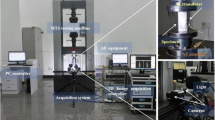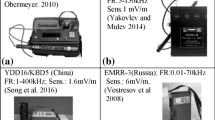Abstract
In situ stress measurement is not well accepted yet in Indonesia due to the unavailability of technology, high costs and because it is impractical in remote regions. Alternatively, the Kaiser effect of acoustic emission (AE) can be used as a method for determining the stress-state at depth, without creating induced stress and is practical in remote areas. This paper is focused on the development of the AE test. The research has started to study the phenomenon of stress memory in a rock sample, the factors influencing the phenomenon, and finally, to determine the in situ stresses around underground excavations by applying the AE method. It is expected that knowledge in gaining the most important input parameters for maintaining the stability of underground excavations can be well understood and be reliably conducted at a reasonable cost.









Similar content being viewed by others
References
Abu Sayed AS, Brechtel CE (1976) Experimental investigation of the effects of size on the uniaxial compression strength of Cedar City Quartz Diorite. In: 17th US symposium on rock mechanics, 5D6, pp 1–9
Bieniawski ZT (1968) The effect of specimen size on compressive strength of coal. Int J Rock Mech Min Sci 5:325–335
Deere DU, Miller RP (1966) Engineering classification and index properties for intact rock, Air Force Weapons Laboratory Technical Report AFWL-TR-65-116, p 277
Einstein HH, Baecher GB, Hirschfeld RC (1970) The effect of size or the strength of a brittle rock. In: Proceedings of 2nd international congress on rock mechanics, Belgrade, vol 2, pp 7–13
Freidel MJ, Thill RE (1990) Stress determination in rock using the Kaiser Effect. Report Investigation No. 9286, United State Bureau of Mines, p 20
Goodman RE (1963) Subaudible noise during compression of rocks. Geol Soc Am Bull 74:487–490
Herget G (1988) Stresses in rock. Balkema, Rotterdam
Hoek E, Brown ET (1980) Underground excavations in rock. Institution of Mining and Metallurgy, London
Holcomb DJ (1993) General theory of the Kaiser Effect. Int J Rock Mech Min Sci Geomech Abstr 30(7):929–935
Jiang X, Shu-chun L, Yun-qi T, Xiao-jun T, Xin W (2009) Acoustic emission characteristic during rock fatigue damage and failure. In: The 6th international conference on mining science and technology. Procedia Earth and Planetary Science, vol 1, pp 556–559
Jingen D, Kangping W, Rong Zun H (1995) In situ stress determination at great depth by using acoustic emission technique. In: Daeman JK, Schlutz RA (eds) Proceedings of international conference on rock mechanics, pp 245–250
Kanagawa T, Hayashi M, Nakasa H (1976) Estimation of spatial geostress components in rock samples using the Kaiser effect of acoustic emission. Technical Report, Central Research Institute of Electrical Power Industry, Abiko, Japan, E375017
Kostak B, Bielenstein HU (1971) Strength distribution in hard rock. Int J Rock Mech Min Sci 8:501–521
Kramadibrata S, Jones IO (1993) Size effect on strength and deformability of brittle intact rock. In: The 2nd international workshop on scale effects in rock masses, Lisbon, Portugal, pp 277–284
Lacidogna G, Carpinteri A, Manuello A, Durin G, Schiavi A, Niccolini G, Agosto A (2010) Acoustic and electromagnetic emissions as precursor phenomena in failure processes. Strain 1–9. doi:10.1111/j.1457-1305.2010.00750.x
Li C, Nordlund E (1993) Experimental verification of the Kaiser Effect in rocks. Rock Mech Rock Eng 26(4):333–351
Li SC, Xu J, Tao YQ (2007) Study on damages constitutive model of rocks based on lognormal distribution. J Coal Sci Eng 4:430–433
Lundborg H (1967) The strength-size relation of granite. Int J Rock Mech Min Sci 4:269–272
Michihiro K, Hata K, Fujiwara T, Yoshioka H, Tanimoto T (1989) Study on estimating initial stress and predicting failure on rock masses by acoustic emission. In: Proceedings of international symposium on rock at great depth, Pau, pp 1025–1032
Mogi K (1962) Study of the elastic shocks caused by the fracture of heterogeneous materials and its relation to earthquake phenomenon. Bull Earthq Res Inst 40:125–173
Pratt HR, Black AD, Brown WS, Brace WF (1972) The effect of specimen size on the mechanical properties of unjointed diorite. Int J Rock Mech Min Sci 9:513–529
Seto M, Nag DK, Vutukuri VS (1999) In situ rock stress measurements from rock cores using the acoustic emission method and deformation rate analysis. Geotech Geol Eng 17:1–26
Simmons GR, Siegfried W, Feves M (1974) Differential strain analysis: a new method for examining cracks in rocks. J Geophys Res 79:4383–4385
Strickland FD, Ren NK (1980) Use of differential strain curve analysis in predicting the in situ stress state for deep wells. In: Proceedings of 21st US symposium on rock mechanics, Rolla, pp 523–532
Teufel LW (1981) Frictional properties of jointed welded tuff, Technical report, SAND81-0212. Sandia National Laboratories, Albuquerque
Yoshikawa S, Mogi K (1981) A new method for estimation of the crustal stress from cored rock samples: laboratory in the study case of uniaxial compression. Tectonophysics 74:323–339
Yuan R, Li YH (2008) Theoretical and experimental analysis on the mechanism of the Kaiser effect of acoustic emission in brittle rocks. J Univ Scie Technol Beijing 15(1):1–4
Acknowledgments
Acknowledgements are due to students who did the serial tests of the acoustic emission and Mr. Sudibyo, Mr. Iwan and Mr. Suparman the technicians of the Laboratory of Geomechanics and Mine Equipment of Department of Mining Engineering (DME), Faculty of Mining and Petroleum Engineering (FMPE) of ITB who were greatly involved in this research project. The Indonesian authors would also like to thank Prof. K. Matsui from Kyushu University Japan and his colleagues for their donation of the acoustic emission equipment set and MISTRAS 2001 to the Laboratory of Geomechanics and Mine Equipment of the DME of the FMPE of ITB. The first author also owes thanks to Dr. Seto who exposed to an intensive research on the use of the AE method. It is also important to note that some of the preliminary and intermediate serial tests were funded by Asahi Glass Foundation 2001 and 2006 ITB Research Grant for Hydraulic Fracturing and Acoustic Emission Tests for Determining In situ Stress, respectively. Last but not least, the authors would like to express their gratitude to the Staff of Pongkor Underground Gold Mine. Without their support, this research would not be possible.
Author information
Authors and Affiliations
Corresponding author
Rights and permissions
About this article
Cite this article
Kramadibrata, S., Simangunsong, G.M., Matsui, K. et al. Role of Acoustic Emission for Solving Rock Engineering Problems in Indonesian Underground Mining. Rock Mech Rock Eng 44, 281–289 (2011). https://doi.org/10.1007/s00603-010-0125-2
Received:
Accepted:
Published:
Issue Date:
DOI: https://doi.org/10.1007/s00603-010-0125-2




